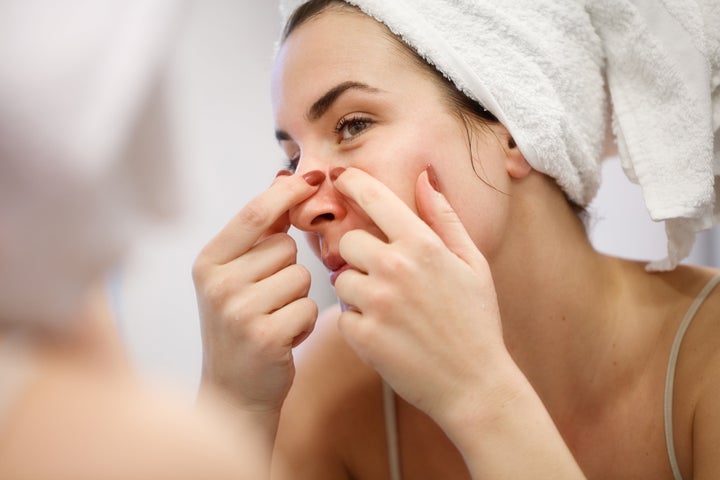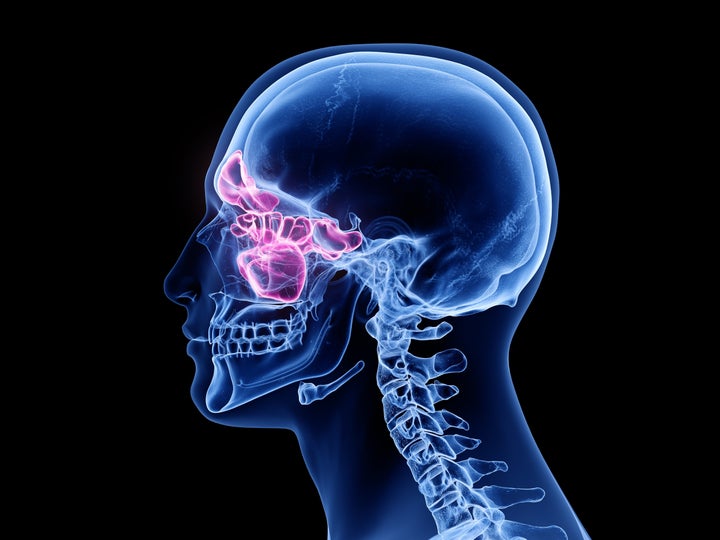
A TikTok with 3.6 million views posted by Dr. Ever Arias, a resident doctor at UCI Medical Center, went viral recently, scaring everyone about what can happen if you pop a pimple on your nose.
The TikTok video shows an AI depiction of a girl telling her personal story of squeezing a pimple that was bothering her, which caused a bacterial infection and eventually killed her. Arias reacts in a video alongside, noting that you should not touch pimples on a part of your face called “the triangle of death.”
Dr. Muneeb Shah, a board-certified dermatologist, also reacted to the story on TikTok, saying in the caption, “This is possible but incredibly rare.”
The AI video appears to be based on a true story about an 18-year-old who died in June in Santa Catarina, Brazil. But it got us wondering ― how much should we worry about this? So we asked dermatologists.
“The triangle of death” that Arias refers to in the TikTok video refers to the nasolabial triangle, which extends from the bridge of your nose down to your upper lip — a place where breakouts, including pimples and blackheads, commonly occur. It’s also an area where large and vital arteries and nerves run from your neck to your sinuses and up to the skull.
Although tempting, popping pimples on this part of your face can cause serious conditions, including nasal infections, vision loss, stroke and even death — so you are better off waiting for any pimples to go away on their own.
“If you pick your face with dirty fingers, dirty nails or have dirty skin, you run the risk of causing a skin infection,” said Dr. Joshua Zeichner, the director of cosmetic and clinical research at the Department of Dermatology at Mount Sinai in New York.
“In the central face, this is particularly risky because the blood in this area drains into a large collection of veins known as the cavernous sinus, which has a direct connection to the brain,” Zeichner said. “So theoretically, bacteria in the bloodstream could spread to the brain, causing a severe, systemic infection.”
Echoing Arias and Shah, Dr. Elizabeth Bahar Houshmand told HuffPost that getting a serious or life-threatening infection due to pimple popping is rare.
However, Houshmand, a double-board certified dermatologist and fellow at the American Academy of Dermatology, noted that “pimple popping does not help and can cause inflammation, pain and potentially permanent scarring.”
“I would recommend avoiding popping pimples in the area of the face connecting the nose to the corners of the mouth,” she said.
Here’s how popping pimples in your nasal area can cause problems.
Your sinuses are hollow spaces located under the brain, behind each eye socket. The cavernous sinus has major arteries and nerves that receive blood from the facial veins — one of which is the internal carotid artery, the most vital supply of blood to the eyes and brain. The jugular vein carries blood from the sinuses away from the brain.

Rarely, nasal infections can lead to serious outcomes. As your blood flows from your nose to other areas of the face, it’s possible for infections from the nasal area to spread to the brain, potentially causing meningitis, brain abscess, or cavernous sinus thrombosis.
When the cavernous sinus is infected, blood in the sinus can clot, which affects the optic nerve function and can cause severe headaches, eye irritation, drooping eyelids, inability to move the eyes, pain or numbness in the face and eyes, fatigue, fever, vision loss or double vision and seizures. Additionally, a blood clot in the sinuses can prevent blood from draining from the brain, which can lead to hemorrhaging as blood leaks into the brain tissues.
A blood clot in the sinuses can also cause complications like impaired speech, difficulty moving the body, fluid pressure in the skull, nerve pressure, brain injury, developmental delays and even death. The mortality rate for septic cavernous sinus thrombosis is 20% to 30%, and complete recovery is rare.
Most infections that cause cavernous sinus thrombosis are bacterial, usually caused by a staph infection. Staph bacteria can live on the face and are usually harmless until a cut (perhaps caused by pinching or squeezing a pimple) causes an infection. More serious staph infections can cause blood poisoning or toxic shock syndrome.
Aside from these more serious consequences, trying to pop a pimple yourself can also lead to permanent acne scars and more noticeable or painful acne, according to the American Academy of Dermatology Association.
“You can disrupt your skin barrier and if the pimple has pus, popping a pimple can spread bacteria into other pores and hair follicles,” Houshmand said. “Many times, you are unable to pop the pimple and may end up pushing the contents of your pimple further underneath the skin. This can clog your pores even more, make acne more noticeable, or trigger inflammation under your skin.”
The Do’s And Don’ts Of Pimple Popping
Despite these risks, some people can’t resist the urge to pop a pimple. What if you do end up popping that pimple on your face? Are there preventative measures you can take to avoid a bacterial infection?
Unfortunately, there is no correct way to pop a pimple, Houshmand says. Instead, dermatologists recommend sticking to a skin care routine to help breakouts go away on their own, washing your hands before you touch your face, and seeing an aesthetician if a pimple is really bothering you.
DO use products that might reduce swelling and infection.
Having a skin care routine that works for you can not only help prevent acne but can also prevent you from picking your face.
“Use preventative measures, like a skin care routine that includes acne-fighting ingredients such as BPO [benzoyl peroxide], hydroxy acids and retinoids,” Houshmand said. “Pimple patches with salicylic acid help to decrease inflammation and because the pimples are covered you won’t be able to pick. If a pimple is inflamed, use a cold compress or ice to help.”
Applying benzoyl peroxide, an over-the-counter medication with anti-bacterial properties, can help metabolise the skin.
“Stick to a benzoyl peroxide, which works by lowering levels of acne-causing bacteria and reducing inflammation in the skin,” Zeichner said.
DON’T try to use aestheticians’ tools at home.
Trying pimple extractions on your own can do more harm than good. According to the Associated Skin Care Professionals, attempting home extractions can damage your pores, spread bacteria and spread the breakout.
Instead, visit a trained aesthetician or trained skin care professional, who will do extractions using the proper skin care products and devices.
“When performed the right way, with clean instruments and without applying too much pressure as to cause trauma to the skin, they can effectively improve the complexion,” Zeichner said. “Trying to pop red, angry pimples or painful undergrounders inevitably leads to more harm than good. These are not poppable pimples, so attempts will result in inflammation, potential infections, or even scars.”
DO wash your hands.
Since infections are caused by spreading bacteria, it’s important to wash your hands before touching your face to make sure harmful bacteria don’t enter the skin barrier. Using a tissue or wet towel can help protect your face.
Touching your face with unwashed hands will not help clear breakouts any faster. Generally, keeping your hands clean can keep unwanted bacteria away from your face.
“Most pimples will resolve on their own,” Shah said.